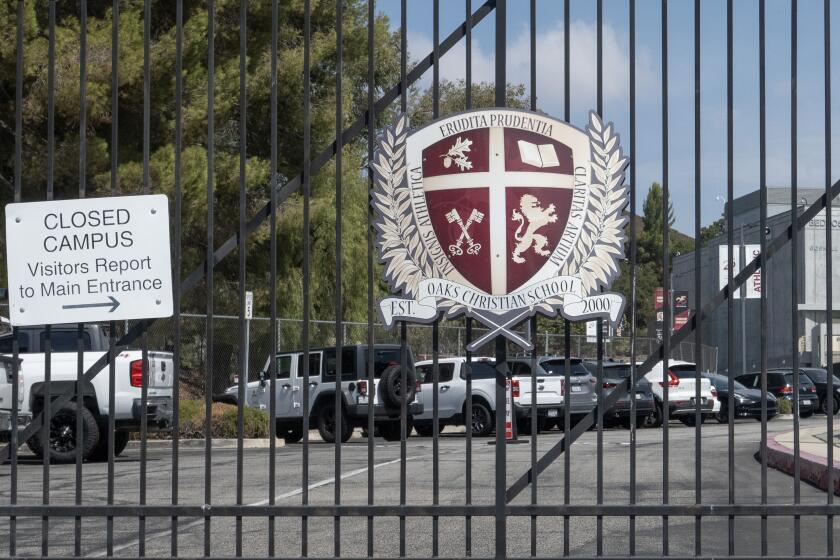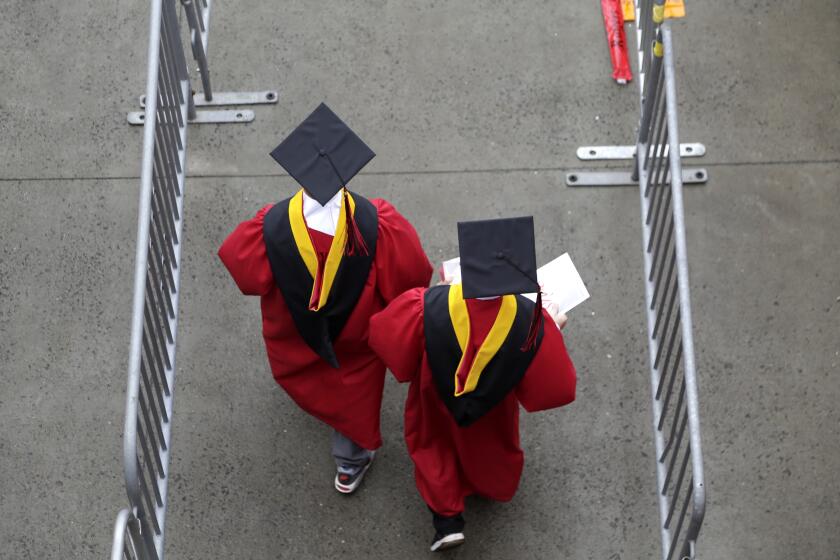Little Progress Made With Classroom Racial Tensions : Education: Many feel need to deal with volatile issues is urgent. But commitment has been lacking.
While grappling with algebraic formulas one day last spring, the high school students found themselves on the brink of violence, struggling with a problem not even their teacher could solve.
Tensions had been brewing inside the Carson High School classroom all year. Asian students took seats on one side of the room, blacks on the other. Some students complained that the teacher paid more attention to high achievers, many of them Asians. The flash point came when a black student, whose question was not promptly answered, accused the Asian teacher of favoring the A students.
Angry words and racial epithets rang out from both sides of the divide. Several students stood up to fight. The teacher managed to quell the flare-up and awkwardly returned to chalkboard formulas. But algebra class would never be the same.
“No one really talked to each other much the rest of the year,” said John Wagner, a student who broke his in-class silence weeks later, only because he failed several quizzes. “I guess bringing up racial issues in class is not the right thing.”
At a time when schoolyards are rife with racial tension and students have witnessed an explosion of civil unrest that their textbooks have not yet recorded, racial issues are often deemed too complex, too potentially volatile for educators to address in the classroom.
Despite frequent outbreaks of arguments and fights between students of different races, a disturbing rise in hate crimes and self-imposed campus segregation among racial groups, little progress has been made within the mammoth Los Angeles Unified School District to teach young people how to bridge the differences that divide them.
“Everyone is telling us we have to get along, but no one is telling us how. We’re expected to live together, but we don’t really understand each other,” said Jai Richardson, 17, a senior at Dorsey High School in Southwest Los Angeles. “We don’t learn enough about our own culture, let alone about someone else’s.”
The Los Angeles riots left many educators feeling an urgent need to deal with racial issues in the city’s schools. In the weeks after the unrest, they responded by dispatching crisis counselors to campuses, provoking discussions about social issues and staging a spate of human relations seminars for staff and students.
But a commitment to multicultural education--a teaching approach that seeks to inject into the classroom an understanding and respect for the diverse cultures that represent American life--has long been lacking, and educators say the schools are now confronted with the consequences of that neglect.
“We are able to talk to students about AIDS, drugs and sex, but we aren’t able to talk to them about race,” said Kenyon Chan, a psychologist who specializes in racism and heads the Asian-American Studies Department at Cal State Northridge. “It’s often the forgotten subject.”
This void in local education, many experts agree, comes at a critical point in the city’s development.
As civic leaders focus on rebuilding Los Angeles, the children who will inherit and maintain the city are sitting next to each other in classrooms, harboring anger, suspicion and fear about each other’s differences.
“We talk a lot of rhetorical garbage about the next generation and then maintain a school system that prepares them for the past,” said Reynaldo F. Macias, a specialist in multicultural education and director of the Linguistic Minority Research Project for the University of California system.
As a result, the racial woes that foment in Los Angeles communities come crashing through the schoolyard gates, with often-debilitating effects on education.
“If children feel the pain and anger of racism in their education, it’s like a weight around their neck,” said CSUN’s Chan. “The weight drags them through the school system and requires energy that is diverted from educational goals. If a kid feels alienated or hurt, it takes a major toll on their ability to concentrate.”
Experts say a range of woes--everything from poor attendance to high dropout rates--can be linked to the sense of alienation that festers in students who feel they are not accepted or valued in their schools.
On the morning last semester that Sherman Oaks Elementary School student Joseph Polissky was to take a standardized state test to evaluate his math and reading skills, the 12-year-old Russian immigrant was called a “vodka-chugger” by a schoolmate for the umpteenth time.
“At first I feel hatred and then I feel sad,” Joseph said, adding that he could not concentrate on the problems before him, he was so angry about his personal troubles at school. “It’s like people at school look at you, but they don’t understand who you are.”
School-age youths say they are barraged with jolting encounters because of their race or culture. In interviews this summer with dozens of students--from elementary to senior high school--young people were surprisingly eager, almost hungry, to talk about their experiences.
Consider, for example, the comments of a roomful of 12- and 13-year-olds from San Fernando Valley junior highs who recently attended a one-day human relations workshop. A teacher asked them to talk about an experience they had in school because of their race:
“I came out of chorus one day and ‘Nigga’ was painted across five lockers,” said a black 12-year-old. “I was so frightened.”
“People call me wetback and border-hopper because they think I’m a Mexican,” said Juan, who is from Argentina and speaks fluent Spanish and English.
“One time I couldn’t keep my feelings inside any longer so I socked him,” said a 12-year-old boy, who reacted after a schoolmate called him a “big-headed Cambodian.”
While adolescent name-calling is not startling, it is significant because it is part of a child’s search to establish his or her identity and to test what is acceptable behavior, said James P. Comer, a professor of child psychology at the Yale University Child Study Center.
Left unchecked, innocent racial slurs can contribute to the development of racist attitudes. For the target, such name-calling leads to building anger and the erosion of self-worth, experts say.
“Schools are paying too little attention to finding constructive ways to empower youth and developing programs that allow them to appreciate other groups,” Comer said.
Although the concept of multicultural education was introduced during the civil rights movement of the 1960s, there is a wide range of opinion over precisely what it is and what it will accomplish, as well as a debate over whether diversifying lessons will erode our national identity.
In practice, multicultural education has come to include a variety of educational approaches, including human relations training, ethnic-specific studies and curriculum reforms that promote diversity.
Much of its success depends on training teachers to bring more diverse perspectives into the classroom. But that is a costly project, one that many shrinking district budgets cannot afford.
Still, some school systems have found creative ways around the financial obstacles.
The 57,000-student Portland, Ore., school district now requires all of its teachers to read a 500-page teaching supplement that provides information on black culture and history. Similar workbooks on Latinos and Asian-Americans will be distributed this year.
Locally, in the Alhambra School District in the San Gabriel Valley, parents are developing a program to mediate conflicts and expand curriculum, in hopes of easing tensions between Latino and Chinese-American students who were involved in a series of schoolyard fights last year.
Even its proponents acknowledge that multicultural education is not a cure-all for the problems of racism. But, said Comer, “when you appreciate customs and differences and you are comfortable around people who are different, you have a greater potential to be less racist, less class conscious, less sexist.”
And in a nation that must depend on a multiethnic work force, preparing students to live and work with other races and cultures may be as important as teaching them to read and write.
As urban school districts across the country become increasingly diverse, there are signs that multicultural education is gaining momentum as an important reform movement of the 1990s.
In the past several years, education departments in several states--including New York, Florida, Wisconsin and California--have adopted policy statements supporting the concept. Some, including California, now require new teacher candidates to take at least one course in multicultural studies.
But, with a one-person unit and a $113,000 annual budget devoted to multicultural education, the huge Los Angeles district has moved slowly to advance multicultural goals, despite its stature as the second-largest and perhaps most diverse school system in the nation.
The district offers a smattering of seminars and workshops, but individual schools and teachers often must draw on their own tight budgets to pay for training or materials to use in class.
One month before the riots, the Los Angeles school board took steps to improve its program, adopting an ambitious multicultural education policy.
The “Educating for Diversity” plan--developed over two years by a panel of more than 40 educators and parents--calls on the district to provide teacher training, assign staff to help schools evaluate curriculum and form human relations teams to better handle conflicts.
But critics say it is short on specifics, and even its supporters doubt the district will be able to deliver on such lofty goals.
“This district doesn’t have money to support fundamental things in the schools, let alone to bring in other plans, as well-purposed as they may be,” said San Fernando Valley school board representative Roberta Weintraub, who voted for the plan.
The school budget crisis that has forced Los Angeles teachers to work harder for less pay has left little enthusiasm for taking on new challenges. Because few instructors know how to deal with racial problems, many fear treading that difficult emotional terrain.
“There is this hesitancy,” said David Williams, a Carson High School English teacher and football coach. “Teachers don’t want to have any discussions that might prove to be incendiary.”
Despite post-riot analysis that identified education as a key factor in improving urban Los Angeles, little so far out of the official rebuilding effort has been aimed at improving relations among young people. Some school officials fear that education will be shortchanged, as government and corporate money is funneled into job training and reconstruction efforts.
School board President Leticia Quezada said one opportunity may already have been missed. “The money used to give those kids a summer job would have been better used to send them to summer camp with kids of other races so they can learn to get along,” she said.
Although the district is 85% minority and draws its 64,000 students from almost every nation in the world, multicultural education has largely been relegated to a series of entertainment theme days that sometimes serve to divide students rather than enlighten them.
The celebrations that feature ballet folklorico dancers on Cinco de Mayo and dancing dragons on Chinese New Year and pack black history into a single month are viewed by many as a kind of educational tokenism that can further entrench stereotypes.
And in fact, on some campuses the celebrations have backfired. At one South Los Angeles high school, for instance, Latino students walked out of a Martin Luther King Day assembly, and then as pay-back, blacks walked out of a Cinco de Mayo assembly.
There are signs of future improvement, however.
Some curriculum reforms are under way, and heralded new history books that include the experiences of previously ignored ethnic groups are available throughout the state--although many districts do not have the money to buy them.
And a groundbreaking high school course, tentatively titled “The New Majority,” is on the drawing board in Los Angeles. The course will present the experiences of various ethnic groups through social themes, such as the justice system and economics.
The development of even that one class, however, is stymied by staff shortages and budget cuts. It will be at least two years before the course is formally introduced.
Even multicultural education’s biggest proponents acknowledge that it is hard to argue for more money to fund innovations when the cash-strapped district has been forced to cut counselors, librarians and nurses. But, they say, the need is so great that lack of money cannot be allowed to serve as an excuse.
“We know that a lot of what is going on in the classroom is harmful to the development of . . . understanding across racial, social and cultural lines,” Macias said. “Yet we are not doing enough to change it and we hide behind a number of shields that say it can’t be done.
“It’s all a question of how much we will tolerate.”
More to Read
Sign up for Essential California
The most important California stories and recommendations in your inbox every morning.
You may occasionally receive promotional content from the Los Angeles Times.










